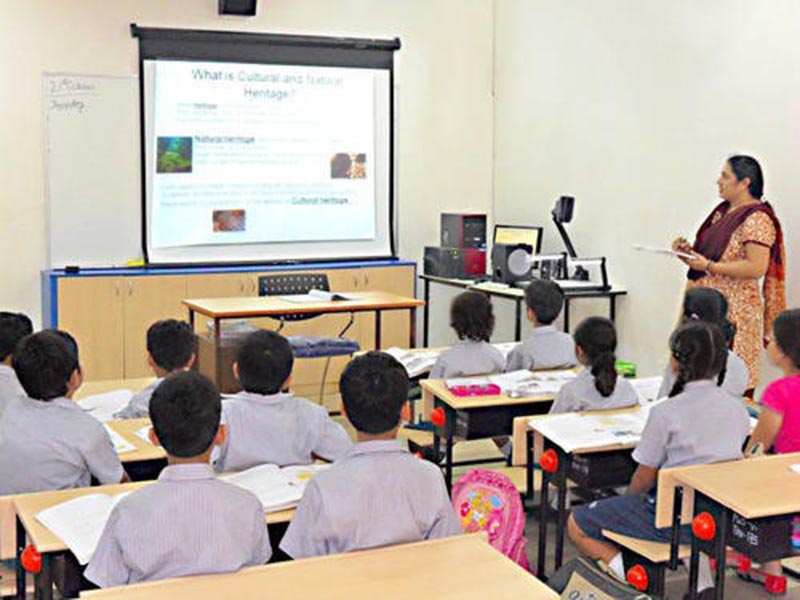Photo: INDRANIL MUKHERJEE | Credit: AFP
First part of a three-part analysis of the Government’s draft New Education Policy.
M. P. Joseph
Having lived through 5 years of the BJP Government’s ongoing attempts to saffronise India’s education, I of course knew that the draft New Education Policy (NEP) that was announced by the Union Minister for Human Resource Development/Education, Prakash Javedekar – a reputed saffronist himself – would be very saffron.
But you could have knocked me down with a feather. Try as I might, I am unable to find much saffron in the draft New Education Policy.
Indeed, the cover of the document which shows an idyllic rural school with birds and creepers all over, is overwhelmingly suffused in red. Red tiles on the school roof, red shirt worn by the child in the school, a woman sitting in the veranda of the school dressed completely top to bottom in red, a red kameez-top worn by a teacher teaching the child wearing the red shirt!
Why, quite unlike any Indian woman I know, even the colour of the hair of that lady in red, is red. And picture this: even the colours of the Indian tricolour painted on the pillars of the school is green, white and – believe you me – more red than saffron!
The surprise did not end there. The contents of the almost 500-pager document was colour neutral. There was hardly any matter in it that seemed to be explicitly Hindutva oriented. Nor did the contents contain anything significant that could be taken to be cultural or history revisionist. It could well have been a document produced under a forward looking UPA III Government.
Perhaps the reason is not far to seek. The genesis of the draft NEP is a document prepared by a ‘Committee for the Evolution of a New Education Policy’ headed by the late TSR Subramaniam IAS – a forward looking former Cabinet Secretary – and the present draft is prepared by a ‘Committee to Draft the New Education Policy’ headed by Padma Vibhushan Dr. K. Kasturirangan. Both the gentlemen and their Committees have focused only on the perpetually developing and live nature of knowledge, that which has no beginning and no end.
Though the NEP is almost half-K pages long, it is very much a vision document – or more correctly a visionary document – that seeks to completely alter the face of higher education in the country. Firstly, it moves away from dividing learning into the silos or verticals of humanities, arts, science, technology, mathematics, engineering, medicine etc. that we are now so used to. Instead it envisions integrating all these into what has come to be known as a liberal arts approach to education. The NEP aims thereby to break down these silos within which many past generations have gone through university education, and hopes thereby to bring in positive outcomes such as increasing critical thinking capacities, deeper learning, mastery of content, problem solving, team work etc. The document however does not quite explain though, how a liberal arts approach of integrating unrelated subjects will lead to these hoped for outcomes. But let us believe nevertheless that they will, and move on.
By 2035, the year by which the NEP is to be fully in place, higher education will look very different in other ways as well. The 800+ universities and 40,000+ colleges we have today – some of which are Deemed to be Universities, others Unitary Universities, still others Universities with Affiliated Colleges, and the thousands upon thousands of affiliating colleges themselves – would also have been integrated into three types of Higher Education Institutions or HEIs.
Type 1 HEIs would have teaching carried out in them but would be focused on research, while Type 2 HEIs would have some research carried out in them, but would be focused on teaching, while Type 3 HEIs would be large stand-alone multi-disciplinary colleges providing Undergraduate, Diploma and Certificate Courses. Universities can be central universities, state universities or private universities.
All the 3 Types of HEIs will have degree granting powers, with autonomy for setting curriculum, deciding on faculty and pedagogy and conducting assessments – or exams as we know it today. Assessments, the document informs us, will no longer be a tool for passing and finding a job, but all assessments would be tailored to the development of the student.
Interestingly none of the three types of HEIs would be mono-field educational institutions, which means that all of these would be multi-disciplinary institutions, combining science, arts, humanities, management etc. with professional courses like engineering, medicine (and that includes nursing and medical technicians) and so on. The type of mono-field universities that we have today – technical universities, medical universities etc. – will be a thing of the past. Thus, IITs, IIMs and perhaps even IISc. that are largely mono-field institutions will disappear or metamorphosis into multi-disciplinary institutions. Would that not be a tragedy? I don’t quite want to sit in judgement now.
Colleges affiliated to a university, that are so ubiquitous today, would go extinct. Instead every such college will develop into large Type 3 HEIs, autonomous degree granting colleges by 2032. Or in 12 years’ time, will have to merge completely with a University of Type 1 or 2 they are now attached to or develop into a Type 1 or 2 University themselves. New colleges being set up will have to receive a charter from a Type I or Type 2 University.
Each of the 3 types of HEIs will be governed by an Independent Board of Governors who will appoint a Vice Chancellor and will have institutional autonomy in deciding upon curriculum, pedagogy, faculty and assessments, with ‘light but not tight regulations’ as the NEP calls it. A Bachelors’ Degree would be a 4-year course with a Bachelor in Liberal Arts BLA or a Bachelor in Liberal Education BLE degree granted thereafter.
Professional and Vocational Education such as Engineering, Medicine, Law, Teacher Education etc. will also be a part of the Liberal Arts Education.
Us Indians have always had this feeling that blue-collar education should not pollute the insides of our pristine universities. Thus skills and vocational training were never allowed inside a university. We created untouchable institutions for them, Industrial Training Institutes ITIs, Industrial Training Centres ITC and Polytechnics. Indeed these institutions did not even come within the ambit of Education Ministries of the Union Government or the Education Departments of the State Government, but were always relegated to be part of the less glamourous Labour Ministry or Labour Departments, and lovingly named the Department of Labour and Vocational Training.
Our attitude to vocational training reflected our Macaulayan view that preparing a child or a young man or woman for a vocation was not education, that education was education only if it prepared the youngsters for a white-collar job.
Creating armies of white collar job-seekers has been the bane of our education system for a very long time. But that is all set to change now, for one of the most vital proposals in the draft NEP is that it completely reimagines vocational and skills training which will henceforth become a part of these 3 types of HEIs. Thus, vocational education will be a part of Professional Education within the overall HEIs. Diplomas, Advanced Diplomas, B. Voc (for Bachelor in Vocation) etc. would be granted by the 3 types of HEIs.
It is then good to see that finally skills and vocational training is set to get the glory it deserves.
The other welcome aspect of the NEP is its focus on research. Macaulayan white collar education did not have much space for research either. And thus, or perhaps even genetically, India never did cultivate a research culture. For us research was only for a PhD that would lead to a Professors job. Research was always a job-provider. The state of our research in universities and in our Defence Research and Development Organization DRDO labs are proof of this culture. But the NEP with its focus on research may change all that. A National Research Foundation NRF that would have an annual budget of Rs. 20,000 crores for research grants disbursed based on a ‘rigorous peer review’ of proposals may just be the right way to go. Hopefully it would seed, grow and facilitate research in institutions in the country, building research capacities through large, long-term mega projects and create linkages between industry, government and researchers.
Just as for higher education, the NEP has a great vision for school education as well.
All good so far. But – and there is always a but – the NEP has some hidden areas that could spell looming danger.
But that, later.
Disclaimer: The opinions expressed within this article are the personal opinions of the author. AlignIndia does not take any responsibility for the content of the article.
M P Joseph is a former Indian and UN Civil Servant. He belongs to the 1978 batch of the IAS and worked with the ILO in India and abroad for 20 years. He can be contacted on mpjoseph@hotmail.co.uk.


